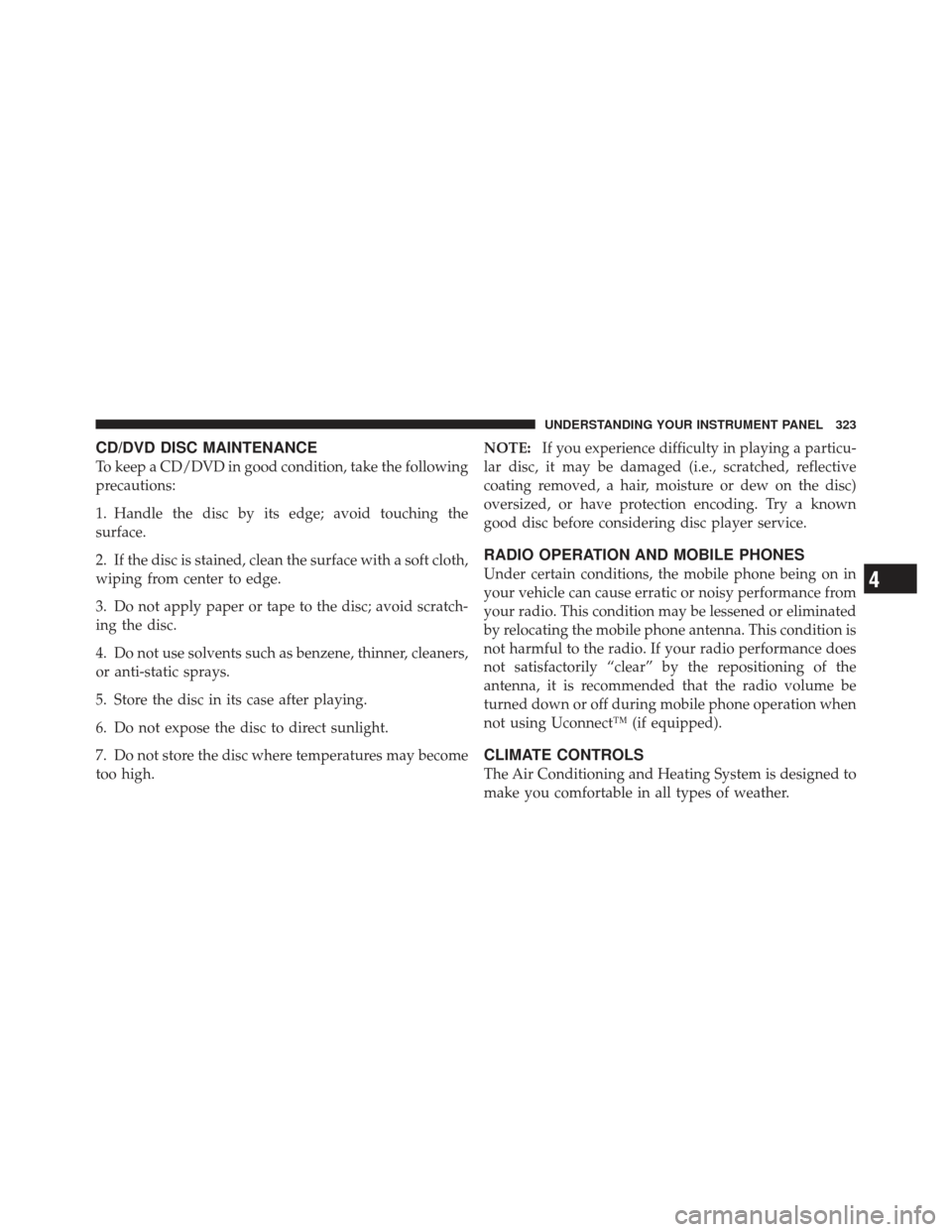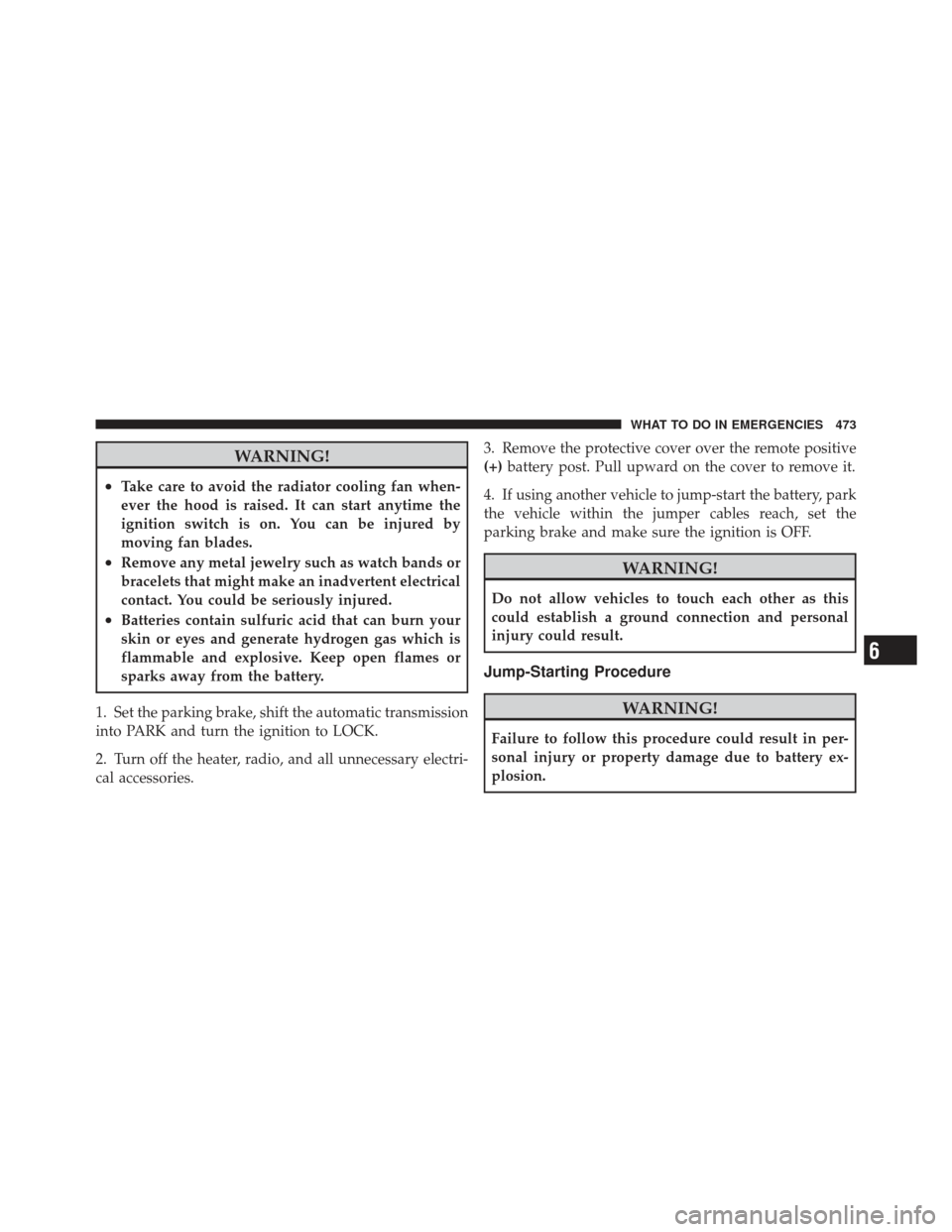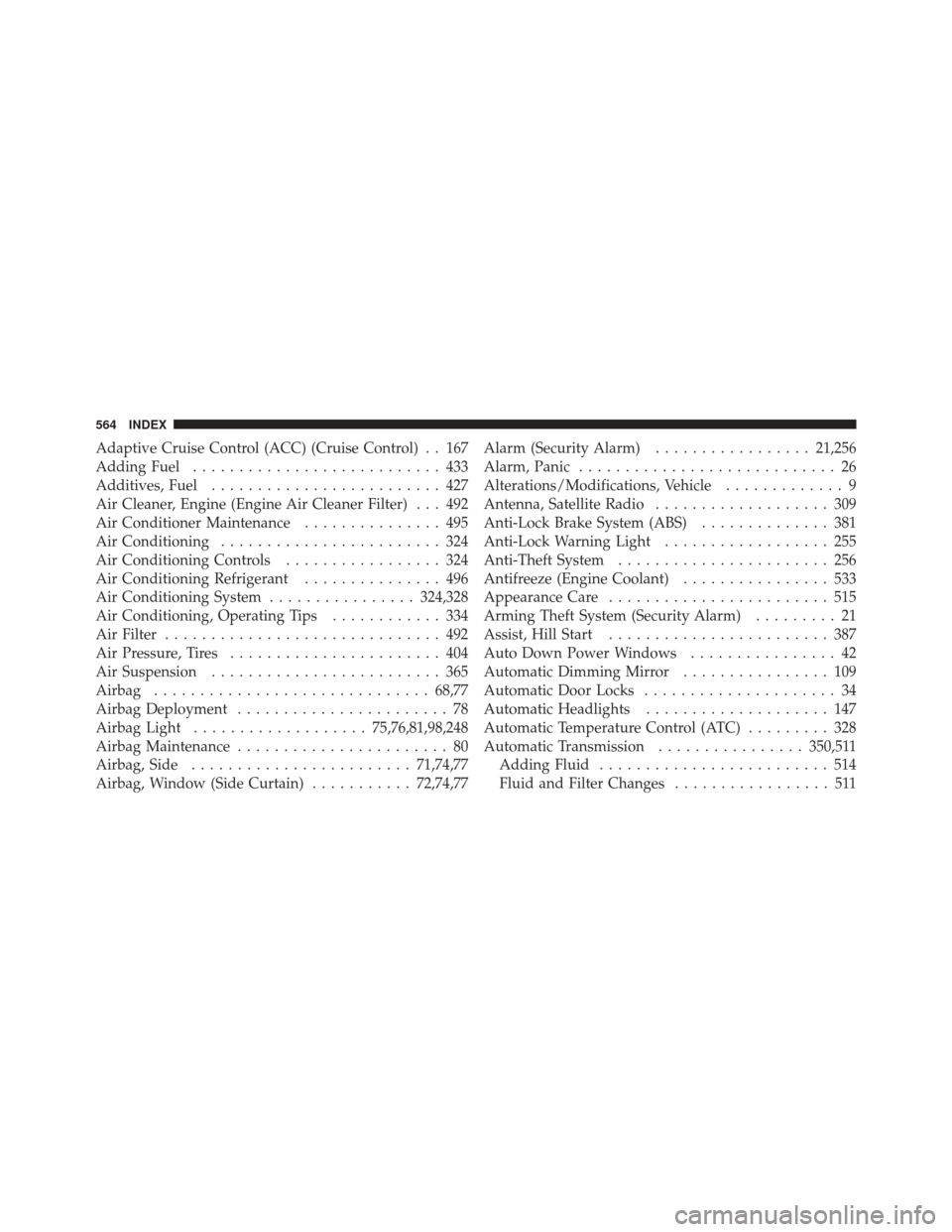Page 324 of 587

Pressing the center button will make the radio switch
between the various modes available (AM/FM/SAT/
CD/HDD/AUX/VES, etc.).
The left-hand control is a rocker-type switch with a
pushbutton in the center. The function of the left-hand
control is different depending on which mode you are in.
The following describes the left-hand control operation in
each mode.
Radio Operation
Pressing the top of the switch will “Seek” up for the next
listenable station and pressing the bottom of the switch
will “Seek” down for the next listenable station.
The button located in the center of the left-hand control
will tune to the next preset station that you have pro-
grammed in the radio preset pushbutton.
CD Player
Pressing the top of the switch once will go to the next
track on the CD. Pressing the bottom of the switch once
will go to the beginning of the current track, or to the
beginning of the previous track if it is within one second
after the current track begins to play.
If you press the switch up or down twice, it plays the
second track; three times, it will play the third, etc.
The center button on the left side rocker switch has no
function for a single-disc CD player. However, when a
multiple-disc CD player is equipped on the vehicle, the
center button will select the next available CD in the
player.
322 UNDERSTANDING YOUR INSTRUMENT PANEL
Page 325 of 587

CD/DVD DISC MAINTENANCE
To keep a CD/DVD in good condition, take the following
precautions:
1. Handle the disc by its edge; avoid touching the
surface.
2. If the disc is stained, clean the surface with a soft cloth,
wiping from center to edge.
3. Do not apply paper or tape to the disc; avoid scratch-
ing the disc.
4. Do not use solvents such as benzene, thinner, cleaners,
or anti-static sprays.
5. Store the disc in its case after playing.
6. Do not expose the disc to direct sunlight.
7. Do not store the disc where temperatures may become
too high.NOTE:
If you experience difficulty in playing a particu-
lar disc, it may be damaged (i.e., scratched, reflective
coating removed, a hair, moisture or dew on the disc)
oversized, or have protection encoding. Try a known
good disc before considering disc player service.
RADIO OPERATION AND MOBILE PHONES
Under certain conditions, the mobile phone being on in
your vehicle can cause erratic or noisy performance from
your radio. This condition may be lessened or eliminated
by relocating the mobile phone antenna. This condition is
not harmful to the radio. If your radio performance does
not satisfactorily “clear” by the repositioning of the
antenna, it is recommended that the radio volume be
turned down or off during mobile phone operation when
not using Uconnect™ (if equipped).
CLIMATE CONTROLS
The Air Conditioning and Heating System is designed to
make you comfortable in all types of weather.
4
UNDERSTANDING YOUR INSTRUMENT PANEL 323
Page 420 of 587

The TPMS consists of the following components:
•Receiver Module
•Four Tire Pressure Monitoring Sensors
•Tire Pressure Monitoring Telltale Light
A low spare tire will not cause the Tire Pressure Moni-
toring Telltale Light to illuminate, a warning message to
appear, or the chime to sound. The Tire Pressure Monitoring Telltale Light will
illuminate in the instrument cluster, a “TIRE LOW
PRESSURE” message will display in the instru-
ment cluster for 5 seconds, and an audible chime will be
activated, when one or more of the four active road tire
pressures are low. Should this occur, you should stop as
soon as possible, check the inflation pressure of each tire
on your vehicle, and inflate each tire to the vehicle’s
recommended cold placard pressure value. The system will automatically update and the Tire Pressure Monitor-
ing Telltale Light will extinguish, once the updated tire
pressures have been received. The vehicle may need to be
driven for up to 20 minutes above 15 mph (24 km/h) to
receive this information.
The Tire Pressure Monitoring Telltale Light will flash on
and off for 75 seconds, and remain on solid when a
system fault is detected. In addition, a “SERVICE TPM
SYSTEM” message may be displayed for approximately
5 seconds when a system fault is detected, and a chime
will sound. If the ignition switch is cycled, this sequence
will repeat, providing the system fault still exists. The
Tire Pressure Monitoring Telltale Light will turn off when
the fault condition no longer exists. A system fault can
occur by any of the following:
1. Jamming due to electronic devices or driving next to
facilities emitting the same Radio Frequencies as the TPM
sensors.
418 STARTING AND OPERATING
Page 421 of 587

2. Installing some form of aftermarket window tinting
that affects radio wave signals.
3. Lots of snow or ice around the wheels or wheel
housings.
4. Using tire chains on the vehicle.
5. Using wheels/tires not equipped with TPM sensors.
NOTE:There is no tire pressure monitoring sensor in
the spare tire. The TPMS will not be able to monitor the
tire pressure. If you install the spare tire, in place of a
road tire, that has a pressure below the low-pressure
warning limit, upon the next ignition switch cycle, a
chime will sound, a “TIRE LOW PRESSURE” message
will be displayed in the instrument cluster for 60 seconds,
and the Tire Pressure Monitoring Telltale Light will turn
ON. After driving the vehicle for up to 20 minutes above 15 mph (24 km/h), the Tire Pressure Monitoring Telltale
Light will flash on and off for 75 seconds and then remain
on solid. In addition, a “SERVICE TPM SYSTEM” mes-
sage will be displayed for 75 seconds. For each subse-
quent ignition switch cycle, a chime will sound, a “SER-
VICE TPM SYSTEM” message will be displayed for
75 seconds, and the Tire Pressure Monitoring Telltale
Light will flash on and off for 75 seconds and then remain
on solid. Once you repair or replace the original road tire,
and reinstall it on the vehicle in place of the spare tire, the
TPMS will update automatically and the Tire Pressure
Monitoring Telltale Light will turn OFF, as long as no tire
pressure is below the low-pressure warning limit in any
of the four active road tires. The vehicle may need to be
driven for up to 20 minutes above 15 mph (24 km/h) in
order for the TPMS to receive this information.
5
STARTING AND OPERATING 419
Page 424 of 587

NOTE:Your system can be set to display pressure units
in PSI, kPa, or BAR.
If the ignition switch is cycled, this sequence will repeat,
providing the system fault still exists. If the system fault
no longer exists, the Tire Pressure Monitoring Telltale
Light will no longer flash, the �SERVICE TPM SYSTEM�message will not be present, and a pressure value will be
displayed instead of dashes. A system fault can occur by
any of the following:
1. Jamming due to electronic devices or driving next to
facilities emitting the same Radio Frequencies as the TPM
sensors.
2. Installing some form of aftermarket window tinting
that affects radio wave signals.
3. Lots of snow or ice around the wheels or wheel
housings.
4. Using tire chains on the vehicle.
5. Using wheels/tires not equipped with TPM sensors.
The EVIC will also display a
�SERVICE TPM SYSTEM�
message for a minimum of five seconds when a system
fault is detected possibly related to the trigger compo-
nent an incorrect sensor location fault. In this case, the
422 STARTING AND OPERATING
Page 475 of 587

WARNING!
•Take care to avoid the radiator cooling fan when-
ever the hood is raised. It can start anytime the
ignition switch is on. You can be injured by
moving fan blades.
•Remove any metal jewelry such as watch bands or
bracelets that might make an inadvertent electrical
contact. You could be seriously injured.
•Batteries contain sulfuric acid that can burn your
skin or eyes and generate hydrogen gas which is
flammable and explosive. Keep open flames or
sparks away from the battery.
1. Set the parking brake, shift the automatic transmission
into PARK and turn the ignition to LOCK.
2. Turn off the heater, radio, and all unnecessary electri-
cal accessories. 3. Remove the protective cover over the remote positive
(+)
battery post. Pull upward on the cover to remove it.
4. If using another vehicle to jump-start the battery, park
the vehicle within the jumper cables reach, set the
parking brake and make sure the ignition is OFF.
WARNING!
Do not allow vehicles to touch each other as this
could establish a ground connection and personal
injury could result.
Jump-Starting Procedure
WARNING!
Failure to follow this procedure could result in per-
sonal injury or property damage due to battery ex-
plosion.
6
WHAT TO DO IN EMERGENCIES 473
Page 525 of 587
Cavity CartridgeFuseMini
Fuse Description
M11 10 Amp RedHeating, Ventilation &
Air Conditioning (Cli-
mate Control System)
M12 30 Amp GreenRadio/Amplifier
M13 20 Amp YellowInstrument Cluster
M14 20 Amp YellowBack Up Camera
M15 20 Amp YellowPower Seat
Module(s)/Adaptive
Cruise Control/Audio
Telematics/Daytime
Running Lights Relay/
Air Suspension
Module/Instrument
ClusterCavity Cartridge
FuseMini
Fuse Description
M16 10 Amp RedOccupant Restraint
Controller
M19 25 Amp NaturalAutomatic Shutdown
1 and 2
M20 15 Amp BlueInstrument Cluster
M21 20 Amp YellowAutomatic Shutdown
3
M22 10 Amp RedHorns (Low/High) –
Right
M23 10 Amp RedHorns (Low/High) –
Left
M24 25 Amp NaturalRear Wiper
M25 20 Amp YellowFuel Pump Motor
Output/Diesel Lift
Pump (Export Only)
7
MAINTAINING YOUR VEHICLE 523
Page 566 of 587

Adaptive Cruise Control (ACC) (Cruise Control) . . 167
Adding Fuel........................... 433
Additives, Fuel ......................... 427
Air Cleaner, Engine (Engine Air Cleaner Filter) . . . 492
Air Conditioner Maintenance ............... 495
Air Conditioning ........................ 324
Air Conditioning Controls ................. 324
Air Conditioning Refrigerant ............... 496
Air Conditioning System ................324,328
Air Conditioning, Operating Tips ............ 334
Air Filter .............................. 492
Air Pressure, Tires ....................... 404
Air Suspension ......................... 365
Airbag .............................. 68,77
Airbag Deployment ....................... 78
Airbag Light ................... 75,76,81,98,248
Airbag Maintenance ....................... 80
Airbag, Side ........................ 71,74,77
Airbag, Window (Side Curtain) ...........72,74,77Alarm (Security Alarm)
.................21,256
Alarm, Panic ............................ 26
Alterations/Modifications, Vehicle ............. 9
Antenna, Satellite Radio ................... 309
Anti-Lock Brake System (ABS) .............. 381
Anti-Lock Warning Light .................. 255
Anti-Theft System ....................... 256
Antifreeze (Engine Coolant) ................ 533
Appearance Care ........................ 515
Arming Theft System (Security Alarm) ......... 21
Assist, Hill Start ........................ 387
Auto Down Power Windows ................ 42
Automatic Dimming Mirror ................ 109
Automatic Door Locks ..................... 34
Automatic Headlights .................... 147
Automatic Temperature Control (ATC) ......... 328
Automatic Transmission ................350,511
Adding Fluid ......................... 514
Fluid and Filter Changes ................. 511
564 INDEX